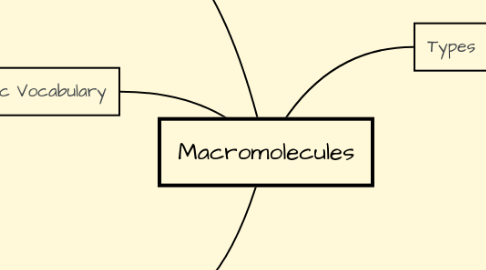
1. Chemical Reactions
1.1. Dehydration Synthesis / Condensation
1.1.1. Uses -OH and -H (or H from -OH) to make bond between monomers, plus molecule of water
1.2. Hydrolysis
1.2.1. "Water Breaking"
1.2.2. Inserts water between monomers
1.2.3. Opposite of condensation reaction
1.2.4. Used in digestion to break down macromolecules into monomers; allows for monomers to be absorbed into cells
2. Chemistry
2.1. Carbon
2.1.1. 6 p, 6 n, 6 e
2.1.2. 4 valence electrons
2.1.2.1. Can form 4 covalent bonds
2.1.2.2. Forms nonpolar bonds with hydrogen
2.1.2.3. Forms polar bonds with oxygen, nitrogen
2.1.3. "Backbone" of all organic molecules
2.1.3.1. Strongest bonds
2.2. Elements
2.2.1. Mostly C, H, O, and N
2.2.2. Trace amounts of P, K, Na, Mg, Ca
2.3. Bonds
2.3.1. Covalent
2.3.1.1. Polar
2.3.1.1.1. Unequal sharing of electrons
2.3.1.1.2. Will allow formation of hydrogen bonds
2.3.1.2. Nonpolar
2.3.1.2.1. Equal sharing of electrons
2.3.1.2.2. Will exclude hydrogen bonds
2.3.1.2.3. Especially between C and H
2.3.1.3. Main component of macromolecules
2.3.2. Ionic
2.3.2.1. Between + and - ions
2.3.2.2. Water will cause dissociation of ions
2.3.2.3. Important in protein tertiary structure
2.3.3. Hydrogen
2.3.3.1. Between slightly + and slightly - of adjacent molecules (not within a molecule!)
2.4. Functional Groups
3. Basic Vocabulary
3.1. Monomer: A small piece that is assembled to make up a macromolecule
3.2. Polymer: Many monomers attached together
3.3. "Macro" = Big
3.4. Hydrophobic: Not interacting with water
3.5. Hydrophilic: Interacting with water
4. Types
4.1. Lipids
4.1.1. Types
4.1.1.1. Triacylglycerol
4.1.1.1.1. Glycerol
4.1.1.1.2. 3 Fatty acids
4.1.1.1.3. Uses
4.1.1.1.4. Glycerol + Fatty acids make ester bonds (type of covalent bonds)
4.1.1.2. Phospholipids
4.1.1.2.1. Used for the cell membrane (2 layers thick)
4.1.1.2.2. Glycerol + 2 fatty acids + 1 phosphate
4.1.1.3. Cholesterol
4.1.1.3.1. Used in cell membranes to keep fluidity
4.1.1.3.2. Used as the basis of all steroids
4.1.1.3.3. 4-ring structure
4.1.1.4. Waxes
4.1.1.4.1. Waterproofing of plants' leaves
4.1.1.5. Pigments
4.1.1.5.1. Used to absorb light
4.1.2. General Characteristics
4.1.2.1. Hydrophobic
4.1.2.2. Made mostly of C-H bonds
4.2. Carbohydrates
4.2.1. General characteristics
4.2.1.1. C:H:O in 1:2:1 ratio
4.2.1.2. Hydrophilic
4.2.1.3. Carbonyl and carboxyl groups
4.2.2. Types
4.2.2.1. Monosaccharides
4.2.2.1.1. Triose (3 carbons)
4.2.2.1.2. Pentose (5 carbons)
4.2.2.1.3. Hexose (6 carbons)
4.2.2.1.4. General information
4.2.2.2. Disaccharides
4.2.2.2.1. Lactose
4.2.2.2.2. Maltose
4.2.2.2.3. Sucrose
4.2.2.3. Polysaccharides
4.2.2.3.1. Glycogen
4.2.2.3.2. Cellulose
4.2.2.3.3. Chitin
4.2.2.3.4. Starch
4.2.2.3.5. Glycosidic Linkages
4.2.2.4. Mnemonic
4.2.2.4.1. If you're MONOgamous (monosaccharide) you will get a Good Girl Friend (or be a good girl friend) (GGF = Glucose, Galactose, Fructose)
4.2.2.4.2. You will DIE (di-saccharide) if you Like My Status (LMS = Lactose, Maltose, Sucrose)
4.2.2.4.3. Polly (polysaccharide) Gets Crappy Crackers Sometimes (Poly = Glycogen, Cellulose, Chitin, Starch)
4.3. Proteins
4.3.1. General Characteristics
4.3.1.1. Monomers
4.3.1.1.1. Amino acids: (alpha) carbon with carboxylic acid, hydrogen, amino group, and "R" group
4.3.1.1.2. Peptide bonds form when H from amino and OH from carboxylic acid undergo condensation reaction
4.3.1.1.3. R Groups: Make the characteristic of the amino acid
4.3.1.2. Levels of Organization
4.3.1.2.1. Primary
4.3.1.2.2. Secondary
4.3.1.2.3. Tertiary
4.3.1.2.4. Quaternary
4.3.1.3. Chaperonins: Help with folding by separating polypeptide from external environment during protein folding
4.3.2. Functions
4.3.2.1. Structural: used for support
4.3.2.1.1. Keratin
4.3.2.1.2. Collagen
4.3.2.2. Hormones: Proteins used for sending chemical messages throughout the body (some hormones are also steroid-based)
4.3.2.2.1. Insulin
4.3.2.3. Immunity: The immune system uses antibodies to defend against invaders
4.3.2.4. Transport: Moving materials into and out of cells along with carrying molecules throughout the blood stream
4.3.2.4.1. Membrane transporters: Pumps, channels etc in the cell membrane to allow materials into and out of cells
4.3.2.4.2. Hemoglobin: delivers oxygen throughout the body in mammals
4.3.2.5. Movement
4.3.2.5.1. Actin and myosin are used in muscles to contract
4.3.2.5.2. Motor proteins: Move cilia and flagella to allow cells to move
4.3.2.6. Enzymes: Proteins that speed up chemical reactions
4.3.2.6.1. End in -ase
4.3.2.6.2. Amylase: Breaks down amylose into glucose molecules
4.3.2.7. Receptors: Cell membrane proteins that are shaped to identify specific chemicals and cause a change within the cell
4.3.2.7.1. Nerve cell receptors detect neurotransmitters and hormones
4.3.2.8. Storage: large proteins for storing excess amino acids
4.3.2.8.1. Albumin in eggs is used for supplying amino acids to a baby chick until it hatches
4.3.2.9. Mnemonics: "HITS ME Really Stinks"
4.3.3. Studying Proteins
4.3.3.1. X-ray crystallography
4.3.3.2. NMR Spec: Nuclear Magnetic Resonance Spectroscopy
4.3.3.3. Bioinformatics
4.4. Nucleic Acids
4.4.1. Nucleotides
4.4.1.1. Phosphate group
4.4.1.2. 5-carbon sugar
4.4.1.3. Nitrogenous base
4.4.1.3.1. Pyrimidine (single ring)
4.4.1.3.2. Purine (double ring)
4.4.1.4. Arrangement:
4.4.2. Polymerization
4.4.2.1. Phosphodiester bonds: Bonds between the 3' hydroxyl of a nucleotide with a 5' phosphate of an adjacent nucleotide to produce the "backbone" of the nucleic acid"
4.4.2.2. Hydrogen bonds: Form between different strands of nucleic acid backbones at the nitrogenous base (reason for base pairing)
4.4.2.2.1. Cytosine and Guanine share three hydrogen bonds (DNA and RNA)
4.4.2.2.2. Adenine and Thymine share two hydrogen bonds (DNA only)
4.4.2.2.3. Adenine and Uracil share two hydrogen bonds (RNA only)
4.4.3. Types and Function
4.4.3.1. DNA: Deoxyribonucleic acid
4.4.3.1.1. Used for storing genetic information
4.4.3.1.2. Comprised of two strands that run in opposite directions (antiparallel)
4.4.3.2. RNA: Ribonucleic acid
4.4.3.2.1. Used for helping to "decode" the DNA into a message and produce a protein
4.4.3.2.2. Comprised of a single strand, but can sometimes fold back on itself to make short double stranded segments
4.4.3.3. ATP: Adenosine triphosphate
4.4.3.3.1. An immediate-use energy molecule that powers the cell's activities; found in all organisms and therefore likely made by the LUCA (last universal common ancestor)
4.4.3.3.2. Made of an adenine (nitrogenous base), ribose, and 3 phosphate groups
